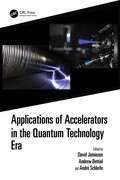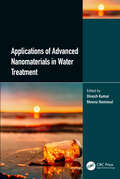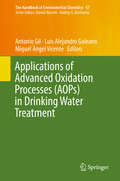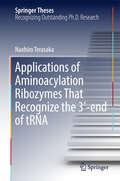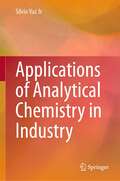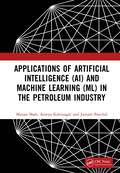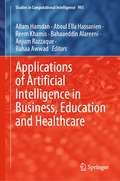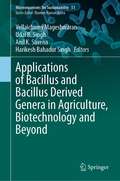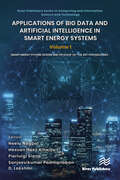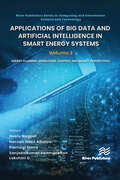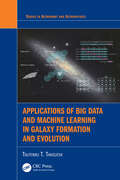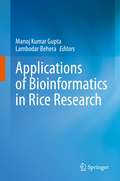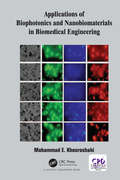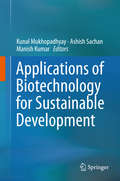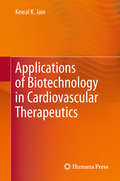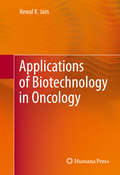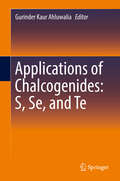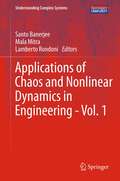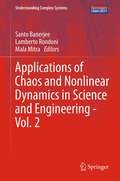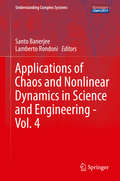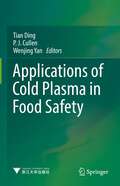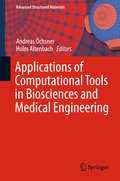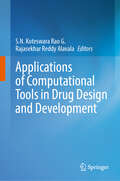- Table View
- List View
Applications of Accelerators in the Quantum Technology Era
by David Jamieson André Schleife Andrew BettiolThis book explores new experimental techniques and theoretical models to deepen an understanding of radiation effects and ion interaction processes in order to design materials for devices for the emerging quantum technology era.Applications include tailored sensors that respond to ionizing radiation and other electromagnetic phenomena; sensors with high radiation hardness; and materials that contain specific engineered defects with desirable optical, magnetic, or electrical properties.The chapters detail direct experimental investigations into the dynamics of radiation-induced defects, including their generation, annihilation, and transformation, on a time scale ranging from femto-seconds to seconds which requires a more detailed understanding to develop the potential of ion beams for the new technology era.It will be a valuable reference for graduate students and researchers that employ ion beams and want to engage in quantum technologies. The book will also be of interest to scientists and engineers from industry that want to make use of ion beams in quantum technologies or learn more about the potential use of ion beams in the field.Key Features:• Provides a comprehensive introduction to this exciting and growing field of research.• Up-to-date with the latest cutting-edge research and practical guidance for researchers and those in industry to apply to their work.• Edited by established authorities, with chapter contributions from subject-area specialists.
Applications of Advanced Nanomaterials in Water Treatment
by Dinesh Kumar Meena NemiwalWater is the most vital substance in every aspect of life, and its contamination because of the activity of mankind poses a big global challenge. Addressing this issue for drinking purposes and environmental protection is the current big issue. Many research groups worldwide have been working on effective treatment technologies based on nanomaterials during the last two decades. Water and wastewater treatment by nanomaterial-based technologies has become an aid in finding possible solutions for contaminated wastewater released from various water sources. Nanoscale materials can be seen to take on unique and unpredictable properties that make them more robust, flexible, lighter, and faster, and the particular material used for the development of devices and systems. Features: • This book presents the use of different advanced nanomaterials to treat water and wastewater. • The uses of carbon-based nanomaterials, metal-organic frameworks (MOFs), and biopolymer-supported nanomaterials for water treatment are explored, focusing on new- generation materials. • Water purification methods such as the disinfection of water using green synthesized nanomaterials, adsorption through nanomaterial-based adsorbents, and nanofiltration techniques are discussed. We emphasize efficient water treatment methods and the use of new emerging nanomaterials in the toxicological study of nanomaterials. Nanomaterials provide high-performance and cost-effective treatment for water treatment. Various nanomaterials and electrochemical methods are used to stop, remove, or neutralize water harmful organic and inorganic contaminants in water through adsorption, filtration, and disinfection.
Applications of Advanced Oxidation Processes (The Handbook of Environmental Chemistry #67)
by Antonio Gil Luis Alejandro Galeano Miguel Ángel VicenteThis volume reviews the drinking water treatments in which AOPs display a high application potential. Firstly it reveals the typical supply sources and limitations of conventional technologies and critically reviews natural organic matter characterization and removal techniques, focusing mainly on AOP treatments. It then explores using AOPs for simultaneous inactivation/disinfection of several types of microorganisms, including highly resistant Cryptosporidium protozoa. Lastly, it discusses relevant miscellaneous topics, like the most promising AOP solid catalysts, the regime change of Fenton-like processes toward continuous reactors, the application of chemometrics for process optimization, the impact on disinfection byproducts and the tracing of toxicity during AOP treatments. This work is a useful reference for researchers and students involved in water technologies, including analytical and environmental chemistry, chemical and environmental engineering, toxicology, biotechnology, and related fields. It is intended to encourage industrial and public-health scientists and decision-makers to accelerate the application of AOPs as technological alternatives for the improvement of drinking water treatment plants.
Applications of Aminoacylation Ribozymes That Recognize the 3′-end of tRNA (Springer Theses)
by Naohiro TerasakaIn this thesis, applications of aminoacylation ribozymes named flexizymes are described. Flexizymes have the following unique characteristics: (i) substrate RNA is recognized by two consecutive base pairs between the 3'-end of substrate RNA and the 3'-end of the flexizyme; (ii) these base pairs can be substituted with other base pairs; and (iii) various activated amino acids can be used as substrates including both canonical and noncanonical amino acids. This flexible aminoacylation of RNAs by flexizymes was used to label endogenous tRNAs to be removed, and in vitro selection using the tRNA-depleted library enabled the discovery of the novel interaction between the microRNA precursor and metabolites. Flexizymes are also used to prepare various aminoacyl-tRNAs bearing mutations at the 3'-end to engineer the translation machinery and to develop the orthogonal translation machinery. The first part of the research demonstrated that SELEX is appropriate for discovering the interaction between small RNA and ligands, and suggested that more RNA motif binding to small molecules exists in small RNAs. The second part opened a door to new opportunities for in vitro synthetic biology involving the engineering of the genetic codes and translation machineries. This research also indicated the great potential of aminoacylation by flexizymes to be applied in various fields of RNA research, which is beneficial for RNA researchers.
Applications of Analytical Chemistry in Industry
by Silvio Vaz JrThis book deals with analytical techniques and methods applied in several sectors of technology and industry and serves as a concise and up-to-date reference for the practical application of analytical chemistry. Divided into 10 chapters, the book starts with an introduction to the fundamentals of analytical chemistry, followed by a review of modern analytical technologies and their application in different industrial sectors and activities such as agrochemicals and pharmaceuticals, ores and mining, polymers, biotechnology, and oil & gas. Particular attention is given to industrial environmental issues, where the author discusses the advanced analytical techniques used to provide quantitative information about pollutants in aqueous and gaseous effluents and their carbon footprint. The book finishes with a chapter summarizing the main remarks and conclusions on advanced analytical techniques used in different industrial sectors, as well as on topics of sustainability, and instrumental analysis. In this book, readers will find valuable insights, including real-life examples, of how classical and instrumental techniques can be used by industry, to help professionals in the quality control of raw materials, products and processes, in the assessment of the formulation contamination, environmental pollution and in the evaluation of sustainability, among others. Given its breadth, the book appeals to professionals (mainly chemists, biochemists, and engineers), researchers, professors, and graduate students.
Applications of Artificial Intelligence (AI) and Machine Learning (ML) in the Petroleum Industry
by Manan Shah Ameya Kshirsagar Jainam PanchalToday, raw data on any industry is widely available. With the help of artificial intelligence (AI) and machine learning (ML), this data can be used to gain meaningful insights. In addition, as data is the new raw material for today’s world, AI and ML will be applied in every industrial sector. Industry 4.0 mainly focuses on the automation of things. From that perspective, the oil and gas industry is one of the largest industries in terms of economy and energy. Applications of Artificial Intelligence (AI) and Machine Learning (ML) in the Petroleum Industry analyzes the use of AI and ML in the oil and gas industry across all three sectors, namely upstream, midstream, and downstream. It covers every aspect of the petroleum industry as related to the application of AI and ML, ranging from exploration, data management, extraction, processing, real-time data analysis, monitoring, cloud-based connectivity system, and conditions analysis, to the final delivery of the product to the end customer, while taking into account the incorporation of the safety measures for a better operation and the efficient and effective execution of operations. This book explores the variety of applications that can be integrated to support the existing petroleum and adjacent sectors to solve industry problems. It will serve as a useful guide for professionals working in the petroleum industry, industrial engineers, AI and ML experts and researchers, as well as students.
Applications of Artificial Intelligence in Business, Education and Healthcare (Studies in Computational Intelligence #954)
by Aboul Ella Hassanien Allam Hamdan Anjum Razzaque Bahaaeddin Alareeni Reem Khamis Bahaa AwwadThis book focuses on the implementation of Artificial Intelligence in Business, Education and Healthcare, It includes research articles and expository papers on the applications of Artificial Intelligence on Decision Making, Entrepreneurship, Social Media, Healthcare, Education, Public Sector, FinTech, and RegTech. It also discusses the role of Artificial Intelligence in the current COVID-19 pandemic, in the health sector, education, and others. It also discusses the impact of Artificial Intelligence on decision-making in vital sectors of the economy.
Applications of Bacillus and Bacillus Derived Genera in Agriculture, Biotechnology and Beyond (Microorganisms for Sustainability #51)
by Harikesh Bahadur Singh Udai B. Singh Anil K. Saxena Vellaichamy MageshwaranThis edited volume provides a comprehensive view of the recent developments on Bacillus and their application in agriculture and allied sectors in a global scenario. Research articles sharing a consolidated state-of-the-art development in this area are solicited for this book. This book is a complete package covering all spheres of diversity and taxonomy, nutrient supplementation, biotic and abiotic stress management, biofilm and endophytic colonization, commercialization and regulatory mechanisms, etc. Descriptions of cutting-edge techniques and novel approaches on Bacillus research is also covered. A part of the book concentrates on the biotic and abiotic stress management in several important crops. It contains 11 contributory chapters from eminent experts in the field of life sciences specially microbiology, plant pathology and biotechnology working on different aspects of Bacilli and their application in agriculture and allied sectors. This book is useful for Graduate, Post-graduate students, research scholars, and post doctorate scholars of plant science, plant microbiology, soil microbiology and plant pathology discipline researchers, academicians, industrialists, policy makers.
Applications of Big Data and Artificial Intelligence in Smart Energy Systems: Volume 1 Smart Energy System: Design and its State-of-The Art Technologies (River Publishers Series in Computing and Information Science and Technology)
by Hassan Haes Alhelou Pierluigi Siano Sanjeevikumar Padmanaban Neelu Nagpal D. LakshmiIn the era of propelling traditional energy systems to evolve towards smart energy systems, including power generation, energy storage systems, and electricity consumption have become more dynamic. The quality and reliability of power supply are impacted by the sporadic and rising use of electric vehicles, domestic loads, and industrial loads. Similarly, with the integration of solid state devices, renewable sources, and distributed generation, power generation processes are evolving in a variety of ways. Several cutting-edge technologies are necessary for the safe and secure operation of power systems in such a dynamic setting, including load distribution, automation, energy regulation & control, and energy trading. This book covers the applications of various big data analytics,artificial intelligence, and machine learning technologies in smart grids for demand prediction, decision-making processes, policy, and energy management. The book delves into the new technologies for modern power systems such as the Internet of Things, Blockchain for smart home and smart city solutions in depth. Technical topics discussed in the book include: • Hybrid smart energy system technologies • Smart meters • Energy demand forecasting • Use of different protocols and communication in smart energy systems • Power quality and allied issues and mitigation using AI • Intelligent transportation • Virtual power plants • AI based smart energy business models • Smart home solutions • Blockchain solutions for smart grids.
Applications of Big Data and Artificial Intelligence in Smart Energy Systems: Volume 2 Energy Planning, Operations, Control and Market Perspectives (River Publishers Series in Computing and Information Science and Technology)
by Hassan Haes Alhelou Pierluigi Siano Sanjeevikumar Padmanaban Neelu Nagpal D. LakshmiIn the era of propelling traditional energy systems to evolve towards smart energy systems, including power generation, energy storage systems, and electricity consumption have become more dynamic. The quality and reliability of power supply are impacted by the sporadic and rising use of electric vehicles, and domestic & industrial loads. Similarly, with the integration of solid state devices, renewable sources, and distributed generation, power generation processes are evolving in a variety of ways. Several cutting-edge technologies are necessary for the safe and secure operation of power systems in such a dynamic setting, including load distribution automation, energy regulation and control, and energy trading. This book covers the applications of various big data analytics, artificial intelligence, and machine learning technologies in smart grids for demand prediction, decision-making processes, policy, and energy management. The book delves into the new technologies such as the Internet of Things, blockchain, etc. for smart home solutions, and smart city solutions in depth in the context of the modern power systems. Technical topics discussed in the book include: • Hybrid smart energy system technologies • Energy demand forecasting • Use of different protocols and communication in smart energy systems • Power quality and allied issues and mitigation using AI • Intelligent transportation • Virtual power plants • AI business models.
Applications of Big Data and Machine Learning in Galaxy Formation and Evolution (Series in Astronomy and Astrophysics)
by Tsutomu T. TakeuchiAs investigations into our Universe become more complex, in-depth, and widespread, galaxy surveys are requiring state-of-the-art data scientific methods to analyze them. This book provides a practical introduction to big data in galaxy formation and evolution, introducing the astrophysical basics, before delving into the latest techniques being introduced to astronomy and astrophysics from data science. This book helps translate the cutting-edge methods into accessible guidance for those without a formal background in computer science. It is an ideal manual for astronomers and astrophysicists, in addition to graduate students and postgraduate students in science and engineering looking to learn how to apply data-science to their research.Key Features: Introduces applications of data-science methods to the exciting subject of galaxy formation and evolution Provides a practical guide to understanding cutting-edge data-scientific methods, as well as classical astrostatistical methods Summarises a vast range of statistical and informatics methods in one volume, with concrete applications to astrophysics
Applications of Bioinformatics in Rice Research
by Manoj Kumar Gupta Lambodar BeheraThis book summarizes the advanced computational methods for mapping high-density linkages and quantitative trait loci in the rice genome. It also discusses the tools for analyzing metabolomics, identifying complex polyploidy genomes, and decoding the extrachromosomal genome in rice.Further, the book highlights the application of CRISPR-Cas technology and methods for understanding the evolutionary development and the de novo evolution of genes in rice.Lastly, it discusses the role of artificial intelligence and machine learning in rice research and computational tools to analyze plant-pathogen co-evolution in rice crops.
Applications of Biophotonics and Nanobiomaterials in Biomedical Engineering
by Mohammad E. KhosroshahiThis book provides a link between different disciplines of nanophysics, biophotonics, nanobiomaterials & applications of nanobiophotonics in biomedical research and engineering. The fundamentals of light, matter, nanobiomaterials & nanophysics are discussed together, and relevant applications in biomedical engineering as well as other related factors influencing the interaction process are explicated. Theoretical and experimental research is combined, emphasizing the influence of crucial common factors on applications.
Applications of Biopolymers in Science, Biotechnology, and Engineering
by Sabu Thomas Arunima Reghunadhan Akhina H.APPLICATIONS OF BIOPOLYMERS IN SCIENCE, BIOTECHNOLOGY, AND ENGINEERING Single volume resource covering the many different applications of biopolymers, along with foundational knowledge like biodegradability and recent advancements Along with providing in-depth discussions on the fundamentals of biopolymers, such as synthesis, fabrication technologies, and properties, Applications of Biopolymers in Science, Biotechnology, and Engineering covers the applications of biopolymers in various fields such as biotechnology, construction and civil engineering, tissue engineering, dairy technology, packaging, electronics, food, medicine, tissue engineering, and biotechnology. Overall, the text conveys a broad overview of the field, enabling readers to grasp both the fundamentals and applications of the subject. Edited by three highly qualified academics with significant experience in the field, Applications of Biopolymers in Science, Biotechnology, and Engineering covers sample topics such as: Biopolymer blends, IPNs, gels, composites, and nanocomposites, and the properties, fabrication and applications of synthetic biopolymers Role of biopolymers and their composites in sustainable agriculture, covering recent developments and future perspectives Polymers suitable for the fabrication of prosthetics, and polymers’ uses in different stages of drug delivery and drug design Life cycle analysis, biodegradability, and advances in the overall field of biopolymers, along with polymers and biopolymers in sensing applications Covering both foundational knowledge and a myriad of applications, Applications of Biopolymers in Science, Biotechnology, and Engineering is an essential resource on the subject for practitioners, researchers, and scientists in polymer science and engineering, materials science, surface science, bioengineering, chemical engineering, and any industry/field interested in biopolymers and/or nanocomposites.
Applications of Biotechnology for Sustainable Development
by Manish Kumar Kunal Mukhopadhyay Ashish SachanThis book discusses different bioprocesses to produce value-added compounds, the science behind their production, the economics of their introduction to the marketplace, their environmental impacts, and their implications for world agriculture. It also provides insights into various technologies and protocols used. The major strength of biotechnology is its multidisciplinary nature and broad range of scientific approaches. Recent advances in various biotechnological fields are facilitating the production of fine chemicals, recombinant proteins, biomaterials and pharmaceuticals. Biotechnology plays an important role, especially in the fields of food production, renewable raw materials and energy, pollution prevention and bioremediation. Biotechnology's greatest contribution is in agriculture - in making crops more efficient. Resource recovery, recycling and hazardous-waste disposal are other environmentally beneficial facets of biotechnology. Thus, biotechnology is a pivotal tool for sustainable development, which has become a priority for the world's policy makers. The concept of sustainable development is based on the goal of increasing the basic standard of living of the world's growing population, without depleting finite natural resources and degrading the environment. Emerging biotechnologies offer novel approaches with the potential to achieve the goal of sustainability and striking a balance between developmental needs and environmental conservation.
Applications of Biotechnology in Cardiovascular Therapeutics
by Kewal K. JainFor physicians, surgeons, and scientists working on cardiovascular disorders, Applications of Biotechnology in Cardiovascular Therapeutics serves as an invaluable reference by collecting the essential writings of Dr. Kewal K. Jain on the topics of biotechnology as they relate to cardiovascular disease. This thorough volume includes such subjects as biotechnology and therapeutic delivery to the cardiovascular system, cell-selective targeted drug delivery, cell and gene therapies, including antisense and RNA interference, cutting-edge gene therapy approaches, as well as personalized cardiology as a way of integrating new technologies into the selection of the best possible treatment for an individual patient. Selected references from recent literature are collected for each chapter, and the text is supplemented by a variety of useful tables and figures. Comprehensive and up-to-date, Applications of Biotechnology in Cardiovascular Therapeutics will be tremendously useful for those working in life sciences and the pharmaceutical sciences, and the inclusion of some basics of cardiovascular diseases will greatly benefit nonmedical readers as well.
Applications of Biotechnology in Oncology
by Kewal K. JainApplications of Biotechnology in Oncology collects key writings by Kewal K. Jain on the most important contributions of biotechnology to cancer research, particularly to the molecular diagnosis of cancer and drug delivery in cancer for personalized management of patients. Basics of various "omics" technologies and their application in oncology are described as oncogenomics and oncoproteomics. This detailed volume also explores molecular diagnostics, nanobiotechnology, cell and gene therapies, as well as personalized oncology. With approximately one thousand selected references from recent literature on this topic and numerous tables and figures, Applications of Biotechnology in Oncology serves as an ideal reference for oncologists, scientists involved in research on cancer biology, and physicians in various specialties who deal with cancer.
Applications of Biotribology in Biomedical Systems
by Ashwani Kumar Abhishek Kumar Avinash KumarThis book summarizes the past, present, and future work in biotribology with a special emphasis on its applications in the design and manufacture of biomedical devices and their potential future uses. The book covers several aspects of biotribology such as biocompatible materials, joint tribology, skin tribology, oral tribology, tribology of the other human bodies or tissues, animal tribology, plant tribology, medical device tribology, and more. This is an essential reference for academics, biomedical researchers, biologists, tribologists, chemists, physicists, biomedical scientists, materials engineers, mechanical engineers and other professionals in related engineering, medicine, and biomedical industries. This book can also serve as a useful research text for undergraduate and graduate engineering courses such as tribology, materials, biomaterials, material characterization, interface science, and biomedical science.
Applications of Chalcogenides: S, Se, and Te
by Gurinder Kaur AhluwaliaThis book introduces readers to a wide range of applications for elements in Group 16 of the periodic table, such as, optical fibers for communication and sensing, X-ray imaging, electrochemical sensors, data storage devices, biomedical applications, photovoltaics and IR detectors, the rationale for these uses, the future scope of their applications, and expected improvements to existing technologies. Following an introductory section, the book is broadly divided into three parts--dealing with Sulfur, Selenium, and Tellurium. The sections cover the basic structure of the elements and their compounds in bulk and nanostructured forms; properties that make these useful for various applications, followed by applications and commercial products. As the global technology revolution necessitates the search for new materials and more efficient devices in the electronics and semiconductor industry, Applications of Chalcogenides: S, Se, and Te is an ideal book for a wide range of readers in industry, government and academic research facilities looking beyond silicon for materials used in the electronic and optoelectronic industry as well as biomedical applications.
Applications of Chaos and Nonlinear Dynamics in Engineering - Vol. 1 (Understanding Complex Systems)
by Lamberto Rondoni Santo Banerjee Mala MitraChaos and nonlinear dynamics initially developed as a new emergent field with its foundation in physics and applied mathematics. The highly generic, interdisciplinary quality of the insights gained in the last few decades has spawned myriad applications in almost all branches of science and technology--and even well beyond. Wherever quantitative modeling and analysis of complex, nonlinear phenomena is required, chaos theory and its methods can play a key role. This volume concentrates on reviewing the most relevant contemporary applications of chaotic nonlinear systems as they apply to the various cutting-edge branches of engineering. The book covers the theory as applied to robotics, electronic and communication engineering (for example chaos synchronization and cryptography) as well as to civil and mechanical engineering, where its use in damage monitoring and control is explored). Featuring contributions from active and leading research groups, this collection is ideal both as a reference and as a 'recipe book' full of tried and tested, successful engineering applications
Applications of Chaos and Nonlinear Dynamics in Science and Engineering - Vol. 2 (Understanding Complex Systems)
by Lamberto Rondoni Santo Banerjee Mala MitraChaos and nonlinear dynamics initially developed as a new emergent field with its foundation in physics and applied mathematics. The highly generic, interdisciplinary quality of the insights gained in the last few decades has spawned myriad applications in almost all branches of science and technology--and even well beyond. Wherever the quantitative modeling and analysis of complex, nonlinear phenomena are required, chaos theory and its methods can play a key role. This second volume concentrates on reviewing further relevant, contemporary applications of chaotic nonlinear systems as they apply to the various cutting-edge branches of engineering. This encompasses, but is not limited to, topics such as the spread of epidemics; electronic circuits; chaos control in mechanical devices; secure communication; and digital watermarking. Featuring contributions from active and leading research groups, this collection is ideal both as a reference work and as a 'recipe book' full of tried and tested, successful engineering applications.
Applications of Chaos and Nonlinear Dynamics in Science and Engineering - Vol. 3 (Understanding Complex Systems)
by Lamberto Rondoni Santo BanerjeeChaos and nonlinear dynamics initially developed as a new emergent field with its foundation in physics and applied mathematics. The highly generic, interdisciplinary quality of the insights gained in the last few decades has spawned myriad applications in almost all branches of science and technology--and even well beyond. Wherever quantitative modeling and analysis of complex, nonlinear phenomena is required, chaos theory and its methods can play a key role. This third volume concentrates on reviewing further relevant contemporary applications of chaotic nonlinear systems as they apply to the various cutting-edge branches of engineering. This encompasses, but is not limited to, topics such fluctuation relations and chaotic dynamics in physics, fractals and their applications in epileptic seizures, as well as chaos synchronization. Featuring contributions from active and leading research groups, this collection is ideal both as a reference and as a 'recipe book' full of tried and tested, successful engineering applications.
Applications of Cold Plasma in Food Safety
by P. J. Cullen Tian Ding Wenjing YanThis book provides readers with a comprehensive overview of cold plasma technology for tackling the various food-related hazards in a wide range of food sectors. The principles and characteristics of cold plasma generation in gas and its interaction with liquids, as well as its combating modes of action for common hazards (e.g., bacteria, spores, biofilms, fungi, and fungal toxins) are emphasized in this book. It also presents the applications of cold plasma or its hurdles with other techniques to assure the microbiological safety of the key food classifications, including fruits, vegetables, cereals, grains, meat, aquatic products, liquid food products (e.g., juices, milk), nuts, spices, herbs, and food packaging. This book is useful for researchers to grasp the comprehensive understandings of how food safety can be controlled with cold plasma technology. This book also provides adequate information for engineers in food industry for better development and optimization of the plasma-generating systems. Government institutions that are responsible for food safety regulations can understand more knowledge about the intricacies and influencing factors, which should be considered for regulating the applications of cold plasma technology in food.
Applications of Computational Tools in Biosciences and Medical Engineering (Advanced Structured Materials #71)
by Andreas Öchsner Holm AltenbachThis monograph presents the latest developments and applications of computational tools related to the biosciences and medical engineering. Computational tools such as the finite element methods, computer-aided design and optimization as well as visualization techniques such as computed axial tomography open completely new research fields with a closer joining of the engineering and bio/medical area. Nevertheless, there are still hurdles since both directions are based on quite different ways of education. Often even the "language" is sometimes different from discipline to discipline. This monograph reports the results of different multi-disciplinary research projects, for example, from the areas of scaffolds and synthetic bones, implants and medical devices and medical materials. It is also shown that the application of computational methods often necessitates mathematical and experimental methods.
Applications of Computational Tools in Drug Design and Development
by S. N. Koteswara Rao G. Rajasekhar Reddy AlavalaThis book provides a comprehensive overview of the role of computers and computational tools at different stages of drug discovery and development. Designed to meet the needs of a beginner to advanced learner, the book provides the information on the tools, how they work, with the latest reports on applications in drug design, drug delivery and building network pharmacology models. Part I explores the pharmacological aspects, covering computational simulation of drug delivery at the molecular level, modeling for formulation design, and the revolutionary use of computational fluid dynamics in pharmaceutical processes. Specific applications such as pharmaceutical die filling processes, inhalation aerosol-based targeted drug delivery, and the development of inhalation compounds using in silico modeling tools are discussed. The use of computational tools in cheminformatics and their application in preformulation perspectives for drug delivery are also included. Part II expands the scope to include solubility prediction, absorption prediction, protein binding prediction, bio-permeability prediction, toxicity prediction, and metabolism prediction. It covers the identification of potential sites of metabolism in lead molecules and computer-assisted simulation studies to understand drug-polymer interactions. Recent advances in drug likeness screening using software and online tools are also reviewed. Part III focuses on specific therapeutic areas. <span class=
